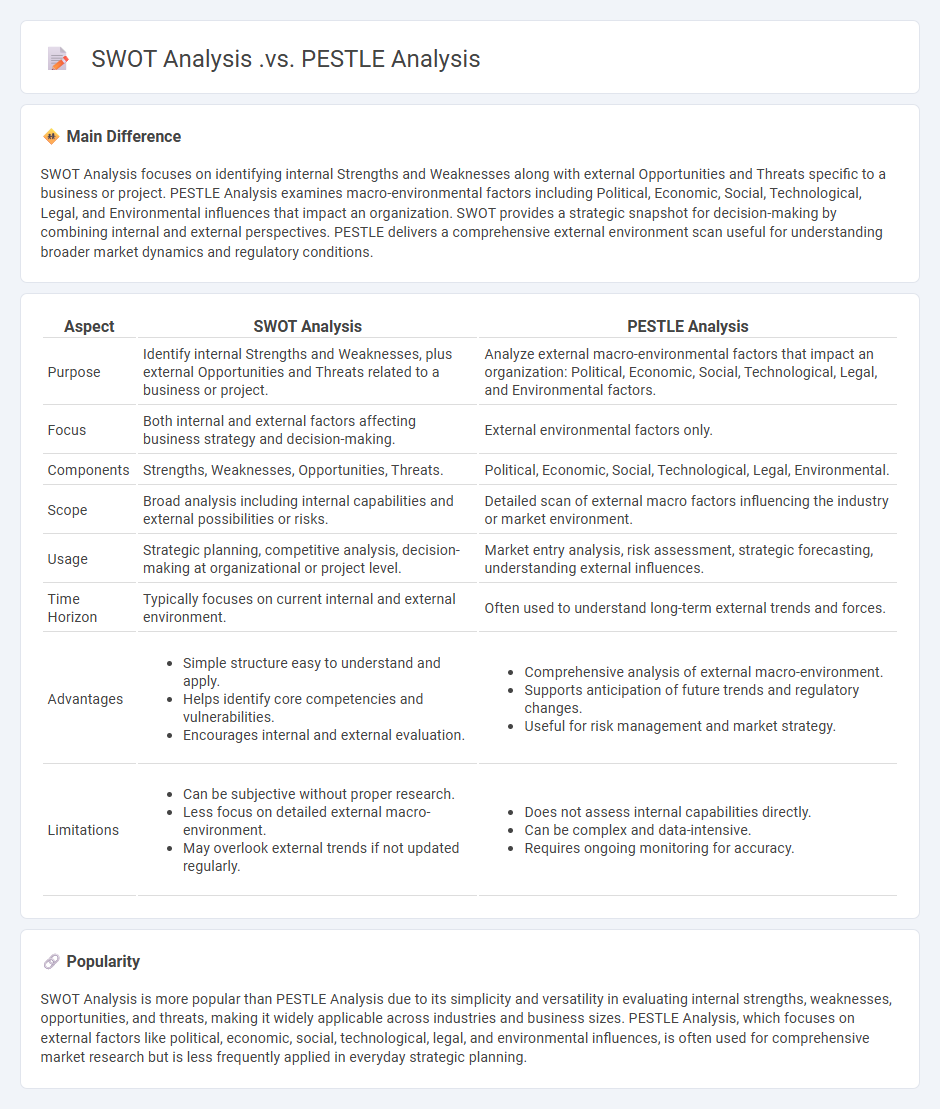
SWOT Analysis evaluates internal strengths and weaknesses alongside external opportunities and threats to inform strategic decisions. PESTLE Analysis examines macro-environmental factors: Political, Economic, Social, Technological, Legal, and Environmental influences impacting an organization. Explore in depth how each framework can enhance business strategy.
Main Difference
SWOT Analysis focuses on identifying internal Strengths and Weaknesses along with external Opportunities and Threats specific to a business or project. PESTLE Analysis examines macro-environmental factors including Political, Economic, Social, Technological, Legal, and Environmental influences that impact an organization. SWOT provides a strategic snapshot for decision-making by combining internal and external perspectives. PESTLE delivers a comprehensive external environment scan useful for understanding broader market dynamics and regulatory conditions.
Connection
SWOT Analysis and PESTLE Analysis are connected through their complementary roles in strategic planning, with PESTLE providing a framework to evaluate external macro-environmental factors such as Political, Economic, Social, Technological, Legal, and Environmental influences, which directly inform the Opportunities and Threats components of SWOT. SWOT then integrates these external insights with internal Strengths and Weaknesses to create a comprehensive overview of an organization's strategic position. Together, they enable businesses to align internal capabilities with external conditions for effective decision-making and long-term success.
Comparison Table
| Aspect | SWOT Analysis | PESTLE Analysis |
|---|---|---|
| Purpose | Identify internal Strengths and Weaknesses, plus external Opportunities and Threats related to a business or project. | Analyze external macro-environmental factors that impact an organization: Political, Economic, Social, Technological, Legal, and Environmental factors. |
| Focus | Both internal and external factors affecting business strategy and decision-making. | External environmental factors only. |
| Components | Strengths, Weaknesses, Opportunities, Threats. | Political, Economic, Social, Technological, Legal, Environmental. |
| Scope | Broad analysis including internal capabilities and external possibilities or risks. | Detailed scan of external macro factors influencing the industry or market environment. |
| Usage | Strategic planning, competitive analysis, decision-making at organizational or project level. | Market entry analysis, risk assessment, strategic forecasting, understanding external influences. |
| Time Horizon | Typically focuses on current internal and external environment. | Often used to understand long-term external trends and forces. |
| Advantages |
|
|
| Limitations |
|
|
Internal Factors
Internal factors in business include elements such as organizational culture, management structure, employee skills, and internal processes. These factors directly influence a company's operational efficiency, decision-making, and overall performance. Strong internal communication and effective resource allocation drive innovation and competitive advantage. Businesses regularly assess these internal components to align strategies with their goals and market demands.
External Factors
External factors significantly influence business operations, including economic conditions, market trends, and regulatory changes. Competitive dynamics within the industry shape strategic decisions, while technological advancements drive innovation and efficiency. Consumer behavior patterns and socio-cultural shifts affect demand and brand perception. Businesses must continuously monitor geopolitical events and environmental factors to mitigate risks and seize opportunities.
Strategic Planning
Strategic planning in business involves setting long-term objectives, analyzing internal and external environments, and allocating resources to achieve competitive advantage. Companies use tools like SWOT analysis, PESTEL framework, and Balanced Scorecard to align their vision with market opportunities and threats. Effective strategic planning drives decision-making processes, enhances organizational agility, and improves financial performance metrics such as ROI and EBITDA. Leading corporations like Apple and Amazon invest heavily in continuous strategic planning to sustain innovation and market leadership.
Market Environment
The market environment in business encompasses all external factors influencing a company's operations, including competitors, customers, suppliers, and regulatory frameworks. Understanding market trends, consumer behavior, and economic conditions is crucial for strategic planning and competitive advantage. Businesses analyze market segmentation, demand fluctuations, and technological advancements to adapt and innovate effectively. Effective market environment analysis drives informed decision-making and sustainable growth.
Decision-Making
Effective decision-making in business relies on data-driven analysis and strategic planning to optimize organizational outcomes. Leveraging advanced analytics and market research enhances the ability to forecast trends and assess risks accurately. Incorporating stakeholder input and aligning decisions with core business objectives strengthen operational efficiency and competitive advantage. Businesses using decision support systems report up to a 25% improvement in project success rates.
Source and External Links
PESTLE and SWOT Analysis - This guide provides a comparison between SWOT and PESTLE analysis, highlighting their differences and how they are used in business planning.
SWOT and PESTLE Analysis - This article discusses the strategic importance of SWOT and PESTLE analyses for evaluating internal and external factors in business planning.
SWOT vs. PESTEL Analysis - This blog post outlines the differences between SWOT and PESTEL analyses, focusing on their scope and application in organizational strategy.
FAQs
What is SWOT analysis?
SWOT analysis is a strategic planning tool that evaluates an organization's internal Strengths and Weaknesses, and external Opportunities and Threats.
What is PESTLE analysis?
PESTLE analysis is a strategic framework used to evaluate external factors affecting an organization, including Political, Economic, Social, Technological, Legal, and Environmental influences.
How do SWOT and PESTLE differ in purpose?
SWOT analysis identifies internal strengths and weaknesses along with external opportunities and threats to assess a company's overall strategic position, while PESTLE analysis examines external macro-environmental factors--Political, Economic, Social, Technological, Legal, and Environmental--that impact an organization's operating environment.
What elements are assessed in SWOT analysis?
SWOT analysis assesses Strengths, Weaknesses, Opportunities, and Threats.
What factors does PESTLE analysis examine?
PESTLE analysis examines Political, Economic, Social, Technological, Legal, and Environmental factors affecting an organization or market.
In what situations is a SWOT analysis more useful?
A SWOT analysis is more useful during strategic planning, market entry assessment, competitive analysis, product development, and project evaluation to identify strengths, weaknesses, opportunities, and threats.
When should you use PESTLE analysis instead of SWOT?
Use PESTLE analysis to evaluate external macro-environmental factors impacting an organization, such as Political, Economic, Social, Technological, Legal, and Environmental influences, while SWOT focuses on internal strengths, weaknesses, opportunities, and threats.
 calledges.com
calledges.com